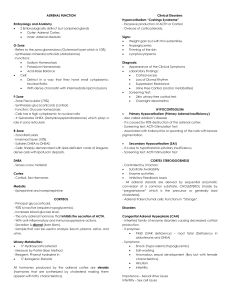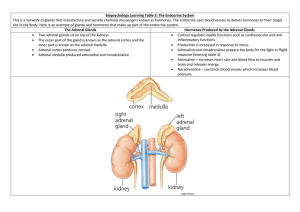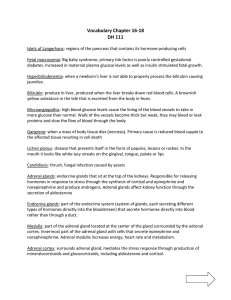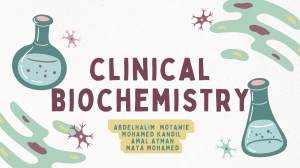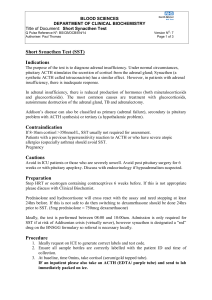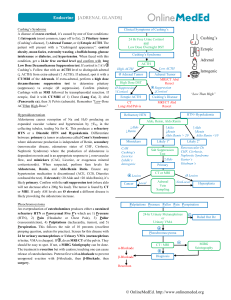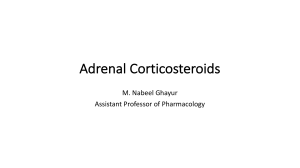MLAB 2401: Clinical Chemistry Keri Brophy-Martinez Disorders of the Adrenal Gland
advertisement
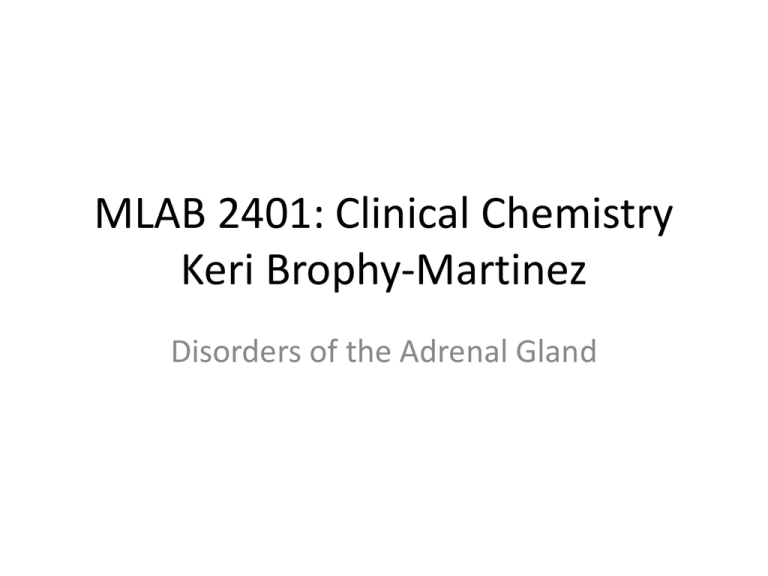
MLAB 2401: Clinical Chemistry Keri Brophy-Martinez Disorders of the Adrenal Gland Addison’s Disease • What is it? – Atrophy or destruction of adrenal cortex (PRIMARY) • Idiopathic • Autoimmune adrenalitis • Tuberculosis – Adrenal insufficiency (SECONDARY) • Hypothalamic/pituitary disease Clinical Features: Addison’s Disease Laboratory • Decreased cortisol levels – Both serum & urine • Decreased aldosterone • Increased ACTH – > 200 pg/mL • • • • • • • • • Manifestations Increased skin pigmentation Tiredness Intestinal issues Hypotension Hypoglycemia Hyperkalemia Hyponatremia/hypocholoremia Loss of body hair Depression Addison’s Disease Increased MSH Increased pigment of skin No inhibition of ACTH Increased ACTH Shrunken Adrenal Cortex Low cortisol Low Aldosterone Cushing’s Syndrome • Caused by: – Excess glucocorticoid production • Cortisol-secreting adrenal carcinoma or adenoma – Prolonged exogenous steroid use • iatrogenic Laboratory Features • Increased serum cortisol – Lack of diurnal variation of cortisol • Hyperglycemia Sunheimer, R., & Graves, L. (2010). Clinical Laboratory Chemistry. Upper Saddle River: Pearson Cushing’s Syndrome • Manifestations – Weight gain in face and abdomen – Buffalo hump back – Muscle wasting/weakness – Easy bruising – Hypertension – Osteoporosis – Hyperglycemia Conn’s Syndrome • Caused by: – Aldosterone-secreting adrenal adenoma of adrenal cortex (Primary) – Disorders within the renin-angiotensin system (Secondary) Clinical Features: Conn’s Syndrome Laboratory • Low serum potassium • High serum sodium • High aldosterone levels • Acid/base imbalances Manifestations • Muscle weakness • Increased urination • Hypertension Adrenal Medulla Disorders • Pheochromocytoma – Benign or malignant tumors in the adrenal medulla – Causes hypertension • Neuroblastoma/Ganlioneuromas – Common malignant tumors in pediatric patients Disorders of Sexual Development Testosterone • Hyperandrogenemia – Increased testosterone production • In females: hirsutism ( see next slide) – Due to tumors in hypothalamus, testicles, or congenital adrenal hyperplasia • Hypoandrogenemia – Decreased testosterone production – Due to infections, tumors, congenital disorders, or decreased function of pituitary/ hypothalamus Hirsutism • Abnormal, abundant, hair growth( lip, chin, side burn, neck) • Loss of female sex characteristics • Ethnic origin important – Italians, eastern europeans, eastern Indian, Irish hCG & Human placental lactogen • hCG – Increased • Hydatidiform mole, choriocarcinoma, pre-eclamptic toxemia – Decreased • Threatened abortion, ectopic pregnancy • Human placental lactogen – Normal to rise throughout gestation – Decreased levels suggest placental malfunction or fetal distress Estrogen • Hyperestrinism – Overproduction of estrogen – Females • Early puberty • Infertility & irregular menses • Postmenopausal bleeding – Males • Testicular atrophy • Breast enlargement Estrogen • Hypoestrinism – Decreased production of estrogen • • • • Ovarian insufficiency Delayed puberty Amenorrhea Turner Syndrome Progesterone • Hyperprogesteronemia – Prevents menstrual cycle • Hypoprogesteronemia – Results in infertility – Abortion of fetus Menstrual Cycle Abnormalities • Average cycle is 28 days • Menopause between 45-55 years • Amenorrhea – Absence of menses – Primary: never menstruated – Secondary: Had at least one menstrual cycle • Oligomenorrhea – Irregular menses – Cycle length in excess of 35- 40 days • Menorrhagia – Uterine bleeding > 7 days References • Bishop, M., Fody, E., & Schoeff, l. (2010). Clinical Chemistry: Techniques, principles, Correlations. Baltimore: Wolters Kluwer Lippincott Williams & Wilkins. • Sunheimer, R., & Graves, L. (2010). Clinical Laboratory Chemistry. Upper Saddle River: Pearson . 19

